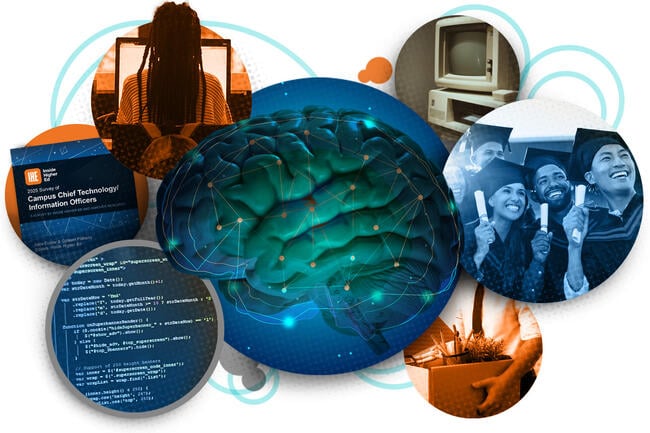You have /5 articles left.
Sign up for a free account or log in.

Just 19 percent of chief technology officers believe higher education is adeptly handling the rise of AI.
Photo illustration by Justin Morrison/Inside Higher Ed | artiemedvedev, Creatas Images, gorodenkoff, LaylaBird, Phira Phonruewiangphing/iStock/Getty Images | Bert/pexels | rawpixel
One in three chief technology and information officers says their institution is significantly more reliant on artificial intelligence than it was even last year, according to the Inside Higher Ed/Hanover Research 2025 Survey of Campus Chief Technology/Information Officers, published today. Yet those same campus tech leaders also indicate their institutions are struggling with AI governance at a time of upheaval for higher education.
The fragmentation in campus technology policies and approaches is only adding “another layer of uncertainty” to the general chaos, said Chris van der Kaay, a one-time college CIO and current higher education consultant specializing in AI policy.
Some additional disconnects: Only a third of campus tech leaders say investing in generative artificial intelligence is a high or essential priority for their institution, and just 19 percent say higher education is adeptly handling the rise of AI.
This, combined with technology companies’ growing influence in society and the sector, raises big questions about college and university agency in defining how AI will shape their futures.
Maintaining Control
“Colleges and universities have to be in control of how AI is being used unless they want the private sector dictating how it will be used at their institutions,” van der Kaay said. “If they want to maintain control and be at the forefront of change, helping institutions adapt and supporting staff and faculty needs—they have to make it a top priority.”
More on the Survey
On Wednesday, June 18, at 2 p.m. Eastern, Inside Higher Ed will present a webcast to discuss the results of the survey. Please register here.
This independent Inside Higher Ed Survey of Campus Chief Technology/Information Officers was supported in part by Softdocs, Grammarly, Jenzabar and T-Mobile for Education.
Inside Higher Ed’s 2025 Survey of Campus Chief Technology/Information Officers was conducted by Hanover Research. The survey included 108 CTOs from public and private institutions, two-year and four-year, for a margin of error of 9 percent. A copy of the free report can be downloaded here.
Between February and March of this year, Inside Higher Ed and Hanover Research sent surveys to 2,197 college and university CTOs. Of the 108 who submitted responses, providing a valuable snapshot of this terrain, 59 percent serve on an executive cabinet or council at their institution. But close to half believe their college isn’t fully leveraging their knowledge and insights to inform strategic decisions and planning involving technology.
And it’s in that environment that the majority of CTOs reported both a rise in demand for online education and a lack of formal AI governance: 31 percent say their institution hasn’t created any AI use policies, including those that address teaching, research, student services and administrative tasks.
Similar to last year’s survey results, just 11 percent of CTOs indicate their institution has a comprehensive AI strategy, while about half (53 percent) believe their institution puts more emphasis on thinking about AI for individual use cases than thinking about it at an enterprise scale.
“AI has implications for every single area of an organization. It’s not just another technology we have to learn. It’s much broader than that,” van der Kaay said. “AI has us not only thinking about how we’re doing things but why we’re doing them, which is why it’s important to have that enterprise-level thinking in using these tools. If we’re just trying to use AI to accomplish things based on decades-old policies, processes, procedures—that’s not the most effective use.”
Ultimately, van der Kaay said he’s “optimistic that it’s giving us an opportunity here to make a lot of meaningful change.”
Digital Divides and Risks Persist
But the rise of AI has also heightened long-standing problems for colleges and universities, including access divides and cybersecurity concerns.
As the technology allows hackers to carry out larger-scale, more sophisticated breaches, only three in 10 CTOs are highly confident their college’s practices can prevent cyberattackers from compromising data and intellectual property, or launching a ransomware event. Van der Kaay said that while this likely reflects the cautious mindset of many CTOs, creating sound cybersecurity policy underscores the need for a cohesive, campuswide technology strategy.
“You don’t want an IT department just locking down stuff without working collaboratively with the faculty and staff to make sure there’s no impact on the learning process,” he said, noting that cybersecurity systems are also expensive. “If CTOs are not engaged with senior leadership and education planning at the highest level, that’s a problem.”
Beyond internal discussions and challenges, external influences are forcing rapid changes to the resources, focus and delivery of higher education.
Since President Donald Trump began his second term in January, his administration has cut billions in federal research funding to higher education institutions, leaving even wealthy institutions with craters in their budgets. At the same time, large technology companies are marketing AI-driven products to colleges and students as tools capable of moving the needle on student success—though many in the academic community are still skeptical of those claims.
Student success is also top of mind for CTOs surveyed, including 68 percent who say leveraging data for student success insights is a high or essential priority in digital transformation efforts and 59 percent who say the same of teaching and learning. While 39 percent of CTOs say their institution has set specific goals for digital transformation, none has yet achieved a complete transformation.
Commonly cited barriers to meeting those digital transformation goals are insufficient number of IT personnel, insufficient financial investment and data-quality and/or integration issues.
More on Tech and Student Success
“Data by itself is fine, but it just tells you what’s wrong,” said Glenda Morgan, an education technology market analyst for Phil Hill and Associates. “But you need to take action after, which is harder.” She added that taking effective action to improve student outcomes is even more urgent as of this week, after House Republicans on the Education and the Workforce Committee advanced a bill known as the Student Success and Taxpayer Savings Plan, which would create a risk-sharing program making colleges partially responsible for unpaid student loans.
“Emerging technologies do have a role to play, but probably not as much as many vendors and CTOs might think,” Morgan said. “You need the data to make the moves, but it also needs to be linked to student journeys.”
Days before the House advanced that bill, Trump issued an executive order calling for AI literacy in K-12 schools through public-private partnerships with AI industry groups, nonprofits and academic institutions that will develop those resources.
The results of that AI literacy directive will have implications for higher education, too. While school districts may start requiring their teachers to start using specific education-technology products, university instructors have more autonomy in how they choose to incorporate technology—if at all.
“We’re going to have to respond to that by going to state legislative bodies to get funding to make sure our faculty are prepared to teach AI-literate students and that our students are prepared to go into the workforce,” said Marc Watkins, a lecturer in creative writing and assistant director of academic innovation at the University of Mississippi. “AI isn’t going away; it’s only becoming more advanced. If you don’t actually have a plan to start thinking about what it’s going to look like over the next five years, it’s going to be incredibly hard to catch up.”
But getting the resources to make that happen won’t be like “waving a magic wand,” Watkins emphasized. “It’s going to take time, and a lot of thoughtful purchases and initiatives that involve human beings. It’s not just flipping a switch.”
While some institutions, such as the California State University system, have already made big investments in giving every student access to generative AI tools, the CTO survey suggests that half of colleges don’t grant students access to such tools. And those disparities will only deepen at universities that don’t invest in AI or create comprehensive policies that translate into action.
“You can have a vision statement about AI, but if every school, department and teacher has their own say about how to incorporate AI, it creates a difficult situation to navigate,” Watkins said. “For students, it’s nagging to think about what they should be expected to know about generative AI. How can they be AI-literate and workforce-ready when many faculty still think it’s cheating? We need to have open conversations about how AI is changing knowledge.”




